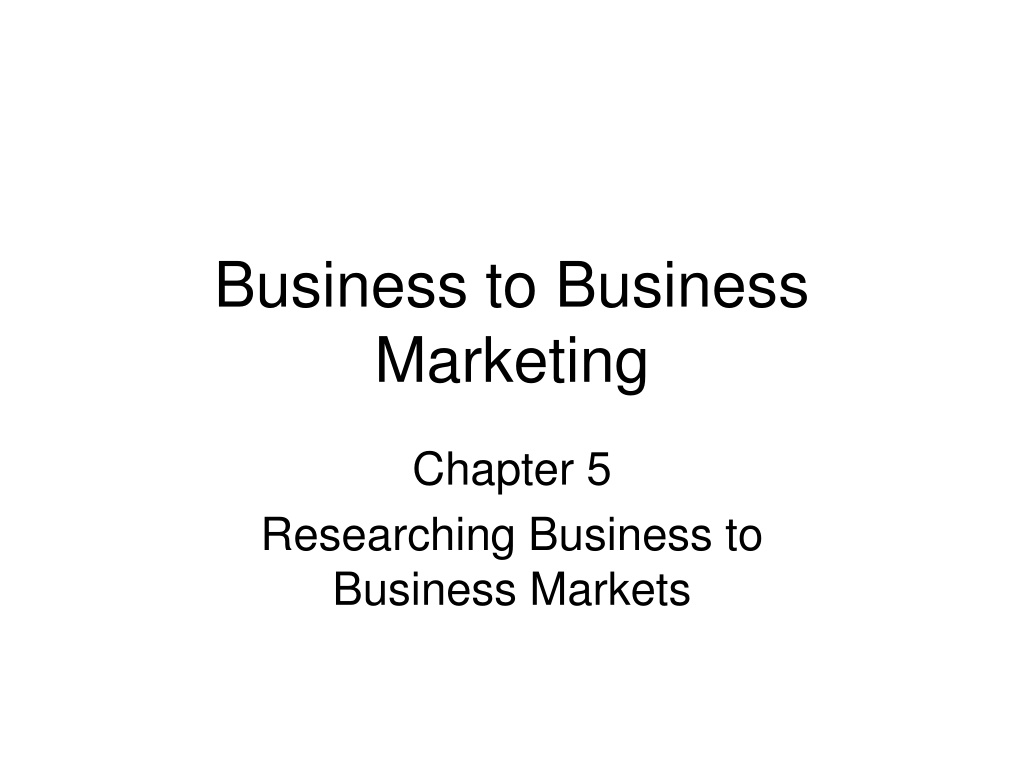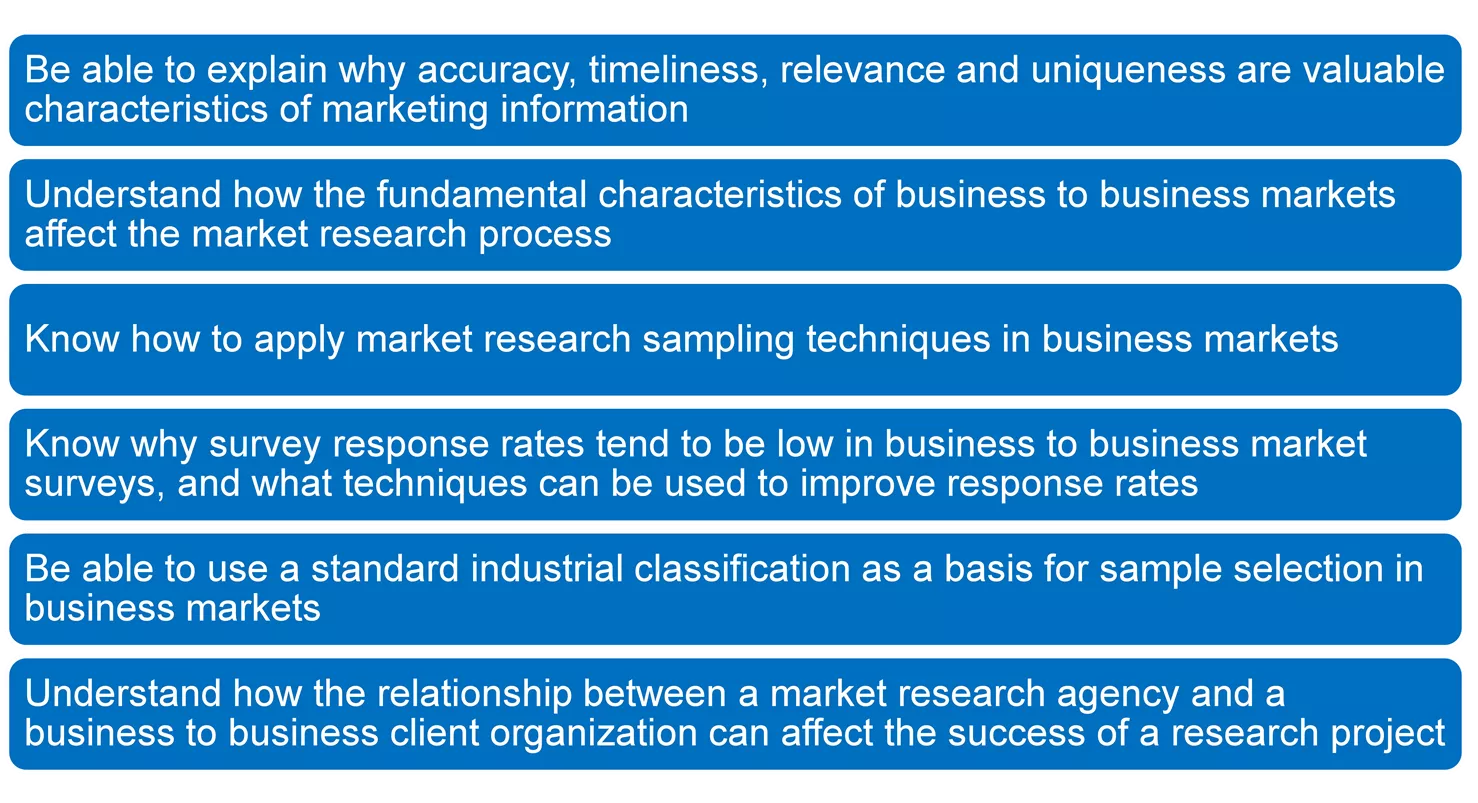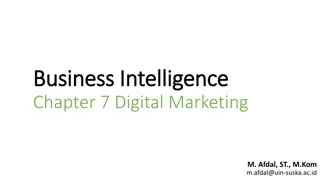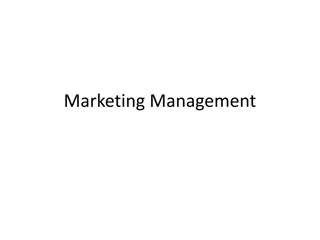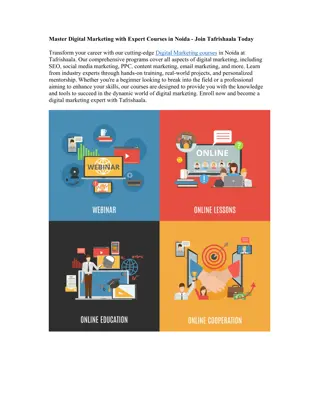Business-to-Business Marketing
Delve into the world of business-to-business market research with a focus on accuracy, timeliness, relevance, and uniqueness of marketing information. Understand the impact of market characteristics on the research process, sampling techniques, survey response rates, and the relationship between research agencies and client organizations. Discover the value of marketing information and the importance of formal market research in successful organizations, along with practical differences in B2B market research. Dive into sampling methods, company size categories, and more in this comprehensive guide.
Download Presentation

Please find below an Image/Link to download the presentation.
The content on the website is provided AS IS for your information and personal use only. It may not be sold, licensed, or shared on other websites without obtaining consent from the author.If you encounter any issues during the download, it is possible that the publisher has removed the file from their server.
You are allowed to download the files provided on this website for personal or commercial use, subject to the condition that they are used lawfully. All files are the property of their respective owners.
The content on the website is provided AS IS for your information and personal use only. It may not be sold, licensed, or shared on other websites without obtaining consent from the author.
E N D
Presentation Transcript
Business to Business Marketing Chapter 5 Researching Business to Business Markets
Learning outcomes Be able to explain why accuracy, timeliness, relevance and uniqueness are valuable characteristics of marketing information Understand how the fundamental characteristics of business to business markets affect the market research process Know how to apply market research sampling techniques in business markets Know why survey response rates tend to be low in business to business market surveys, and what techniques can be used to improve response rates Be able to use a standard industrial classification as a basis for sample selection in business markets Understand how the relationship between a market research agency and a business to business client organization can affect the success of a research project
Value of marketing information Accuracy Timeliness Relevance Uniqueness
Using market research There is good evidence that more successful business to business marketing organizations make more use of formal market research than those that are less successful.
B2B market research Although many aspects of market research are the same in business and consumer markets such as sampling theory there are several practical differences that arise from the basic features of business markets. As well as understanding their direct customers, business marketers need to be aware of developments further downstream in the chain of derived demand, at the level of their customer s customer and perhaps even beyond that.
Probability sampling Non-probability sampling Simple random sampling Convenience sampling Stratified random sampling Snowball sampling Systematic sampling Quota sampling Cluster/multistage sampling Focus groups Table 5.1: Sampling methods
Company size categories 1 to 9 employees 10 to 99 employees 100 or more employees 5% Total Proportion in population 85% 10% 100% Primary industries Manufacturing industries Service industries Total 5% 425 50 25 500 25% 2125 250 125 2500 70% 5950 700 350 7000 100% 8500 1000 500 10000 Table 5.2: Illustrating stratified random sampling
Electronic methods of survey delivery www.onlinesurveys.ac.uk www.surveywriter.net www.surveymonkey.com www.surveysystem.com www.surveycrafter.com
SIC A standard industrial classification (SIC) is a systematic method of classifying economic activity, originally designed by governments, which is useful for specifying business market research samples from list providers and for defining an industry sector unambiguously.
UK SIC(2007) Sections of the UK SIC (2007) A Agriculture, forestry and fishing B Mining and quarrying C Manufacturing D Electricity, gas, steam and air conditioning supply E Water supply, sewerage, waste management and remediation activities F Construction G Wholesale and retail trade; repair of motor vehicles and motorcycles H Transport and storage I Accommodation and food service activities J Information and communication K Financial and insurance activities L Real estate activities M Professional, scientific and technical activities N Administrative and support service activities O Public administration and defence; compulsory social security P Education Q Human health and social work activities R Arts, entertainment and recreation S Other service activities T Activities of households as employers; undifferentiated goods and services producing activities of households for own use U Activities of extraterritorial organisations and bodies
UK SIC(2007) 17 Manufacture of paper and paper products 17.1 Manufacture of pulp, paper and paperboard 17.11 Manufacture of pulp 17.12 Manufacture of paper and paperboard 17.2 Manufacture of articles of paper and paperboard 17.21 Manufacture of plastic products 17.21/1 Manufacture of corrugated paper and paperboard; manufacture of sacks and bags of paper 17.21/9 Manufacture of paper and paperboard containers other than sacks and bags 17.22 Manufacture of household and sanitary goods and of toilet requisites 17.23 Manufacture of paper stationery 17.24 Manufacture of wallpaper 17.29 Manufacture of other articles of paper and paperboard 68 Real estate activities 68.1 Buying and selling of own real estate 68.10 Buying and selling of own real estate 68.2 Renting and operating of own or leased real estate 68.20 Renting and operating of own or leased real estate 68.20/1 Renting and operating of Housing Association real estate 68.20/2 Letting and operating of conference and exhibition centres 68.20/9 Letting and operating of own or leased real estate (other than Housing Association real estate and conference and exhibition services) n.e.c. 68.3 Real estate activities on a fee or contract basis 68.31 Real estate agencies 68.32 Management of real estate on a fee or contract basis
